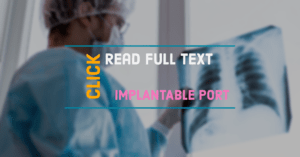Combined intracavitary ECG and ultrasound for CVC placement – Full Text

“The combined use of ultrasound and intracavitary ECG localization in critically ill patients undergoing central venous catheterization can help increase the success rate of catheter placement, shorten the catheter placement duration, reduce the incidence of various catheter-related complications, and also reduce the length of stay and hospitalization expenses” Pan et al (2024).
Kurin Lock for blood culture collection – NICE guidance – Full Text

“Clinical trial evidence suggests that Kurin Lock is a safe and effective way of reducing blood culture contamination rates, compared with standard blood culture collection” NICE (2024).
Acyclovir extravasation in a newborn – Full Text

“Early diagnosis of acyclovir extravasation and immediate management could prevent severe complications in neonates. Further studies are needed to suggest a standard approach and treatment protocol for acyclovir extravasation” Shamel and Zarkesh (2024).
Study on adherence to CLABSI prevention guidelines – Full Text

“To investigate adherence to intravascular catheter (IVC) insertion and maintenance guidelines in Chinese tertiary hospitals” Zang et al (2024).
Epidemiological characteristics of needlestick injuries – Full Text

“This study aimed to analyze the epidemiological characteristics of NSI among HCWs and the risk factors influencing NSI rates and to provide further direction for NSI prevention in secondary care hospitals” Rashidov et al (2024).
Long-term intravenous device narrative review

“Improving understanding of the phenomena leading to infectious and thrombotic complications, as well as better knowing the differences between intravenous devices and their respective indications, should lead to improvement of in-hospital and out-of-hospital care” Roche (2024)
Health care staff awareness of peripheral IV catheters

“We conducted a prospective, multi-center, observational point prevalence study to assess awareness of PIV presence among clinicians caring for hospitalized patients in four hospitals between 05/2018 and 02/2019 located in Michigan, United States of America” Adzemovic et al (2024).
Critical care nurses use of POCUS for peripheral IV cannulation – Full Text

“Ultrasound-guided peripheral intravenous access can become a valuable skill for CCN’s caring for patients with DIVA in the intensive care unit” Hansen and Solbakken (2024).
Removal of fractured neonatal PICC

“An infant with a corrected gestational age of 38 weeks, weighing 3.1 kg, was referred to our pediatric surgical department because of a fractured peripherally inserted central venous catheter in the left lower limb with the end retracting into the deep venous system” Visschers et al (2024).
Neonatal health care-associated infection prevention

“We examine specific QI opportunities and approaches to prevent HAIs caused by Staphylococcus aureus , multidrug-resistant gram-negative pathogens, Candida species, and respiratory viruses, and to prevent central line-associated bloodstream infections (CLABSIs) and surgical site infections” Brachio et al (2024).
Weighted blanket to reduce anxiety in the oncology infusion department

“Patients reported reduced anxiety after using a weighted blanket and described weighted blankets as comforting and soothing. More than 90% of surveyed patients agreed or strongly agreed that the blanket was comfortable, not too heavy, and easy to put on, and did not interfere with nursing care or their own activities” Hermann et al (2024).
EDTA lock solution in patients with intestinal failure

“In a compassionate use protocol for high-risk pediatric patients with intestinal failure, the use of 4% T-EDTA reduced composite catheter complications, including those leading to emergency department visits, hospital admissions, additional procedures, and mortality” Hirsch et al (2024).
Peripheral intravenous catheter infection study – Full Text

“PIVC insertion at the wrist or cubital fossa should be avoided whenever possible to reduce the risk of catheter colonization and/or local infection and of positive PIVC tip culture” Drugeon et al (2024).
Medication safety strategies in European intensive care units

“There is considerable variation in medication safety strategies used within European ICUs, both between and within geographical areas. Our findings may be helpful to ICU staff in identifying strategies that should be considered for implementation” Abdelaziz et al (2024).
PICC materials may leach into neonatal patients

“Peripherally inserted central catheters (PICC-lines) used in neonatology are made of thermoplastic polyurethane (TPU) or silicone. These materials usually contain substances that may leach into drug vehicles or blood” Le Basle et al (2024).
Treatment of intravenous iron extravasation – Full Text

“Extravasation of intravenous iron at the site of infusion leads to the iron accumulation in the dermis, resulting in persistent hyperpigmentation that ranges from grayish to brown, known as cutaneous siderosis” Lee et al (2024).
UEDVT in septic shock patients with multiple CVC – Full Text

“Our study suggests that the elevated risk of VTE is likely associated with the insertion of the hemodialysis catheters rather than solely the presence of two concurrent catheters” Trebuian et al (2024).
Impact of first-line dalbavancin for cellulitis – Full Text

“Prescribing dalbavancin as first-line intravenous antibiotic for cellulitis prevents admission, saving bed-days and admission-related costs” Ben-Sassi and Sarwar (2024).
Species identification in positive blood cultures – Full Text

“Direct species identification using the Sepsityper kit is an upcoming approach for blood culture bottles, which were flagged as positive even in patients with hematologic malignancies when the spectral score was ≥ 1.7” Watanabe et al (2024).
Management of malignant superior vena cava syndrome – Full Text

“Superior vena cava (SVC) syndrome occurs due to obstructed blood flow through the SVC. It can present clinically on a spectrum, between asymptomatic and life-threatening emergency” Chow et al (2024).
Ceftazidime extended interval dosing regimens for OPAT – Full Text

“Regimens of ceftriaxone 4 g once a day and ceftazidime 3 g twice a day were well tolerated and highly effective. If widely adopted, these regimens will save OPAT and nursing time and enable more patients to be treated” Wareham et al (2024).
Oncology patients experience of implantable ports – Full Text

“The purpose of this study was to explore the psychological state and needs of tumor patients after implantation of an intravenous infusion port and provide valuable references for psychological interventions” Zhu et al (2024).
Infusion phlebitis clearest predictor of a poor vascular access care – Full Text

Infusion phlebitis clearest predictor of a poor vascular access care Abstract: The management of nursing care regarding patients’ vascular access is a priority. This study determines the contribution of the variables involved in the quality of care and maintenance of vascular access (VA) devices in admitted patients in the Valencian Community. Methods: Using the STROBE […]
Implantable port-related long‑term complications – Full Text

“Therefore, in the present study, a predictive model for long-term complications following TIVAP implantation in patients with lung cancer was developed” Jia et al (2024).
Chemotherapy with implantable arterial access port – Full Text

“Following symptomatic treatment, the patient underwent a therapeutic regimen that combined transarterial infusion port FOLFOX-HAIC with Lenvatinib and Sintilimab” Jiang et al (2024).
Echogenicity of peripheral venous catheters

“The echogenicity of a device is an essential component of successful ultrasound-guided peripheral venous catheter placement. Optimizing catheter intrinsic factors such as components of the cannula and length, and extrinsic factor like the insertion angle should be considered in their design and use to reduce puncture failure rates” Slosse et al (2024).
Ultrasound guided arterial access for combat medics

“Microteaching may be an effective approach to train combat medics in obtaining ultrasound-guided percutaneous femoral artery access. The use of echogenic coatings on needles could be a valuable adjunct and provide advantage in obtaining vascular access” van de Voort et al (2024).
Implantable port and PICC-related complications – Full Text

“Implantable venous access ports are safer than peripherally inserted central catheters for Chinese patients with hematological malignancies” Lu et al (2024).
Management of PICC fracture

“This case suggests that silicone-based PICCs are fragile and have a high risk of spontaneous dislocation. Therefore, they should be replaced with polyurethane-based PICCs” Zeng et al (2024).
Infusion pump education quality improvement project

“This project demonstrated that affixing visual aids and formalizing hands-on education can lead to significantly increased proficiency with infusion medical pumps and efficiency in hanging a new infusion bag” Scheide et al (2024).

